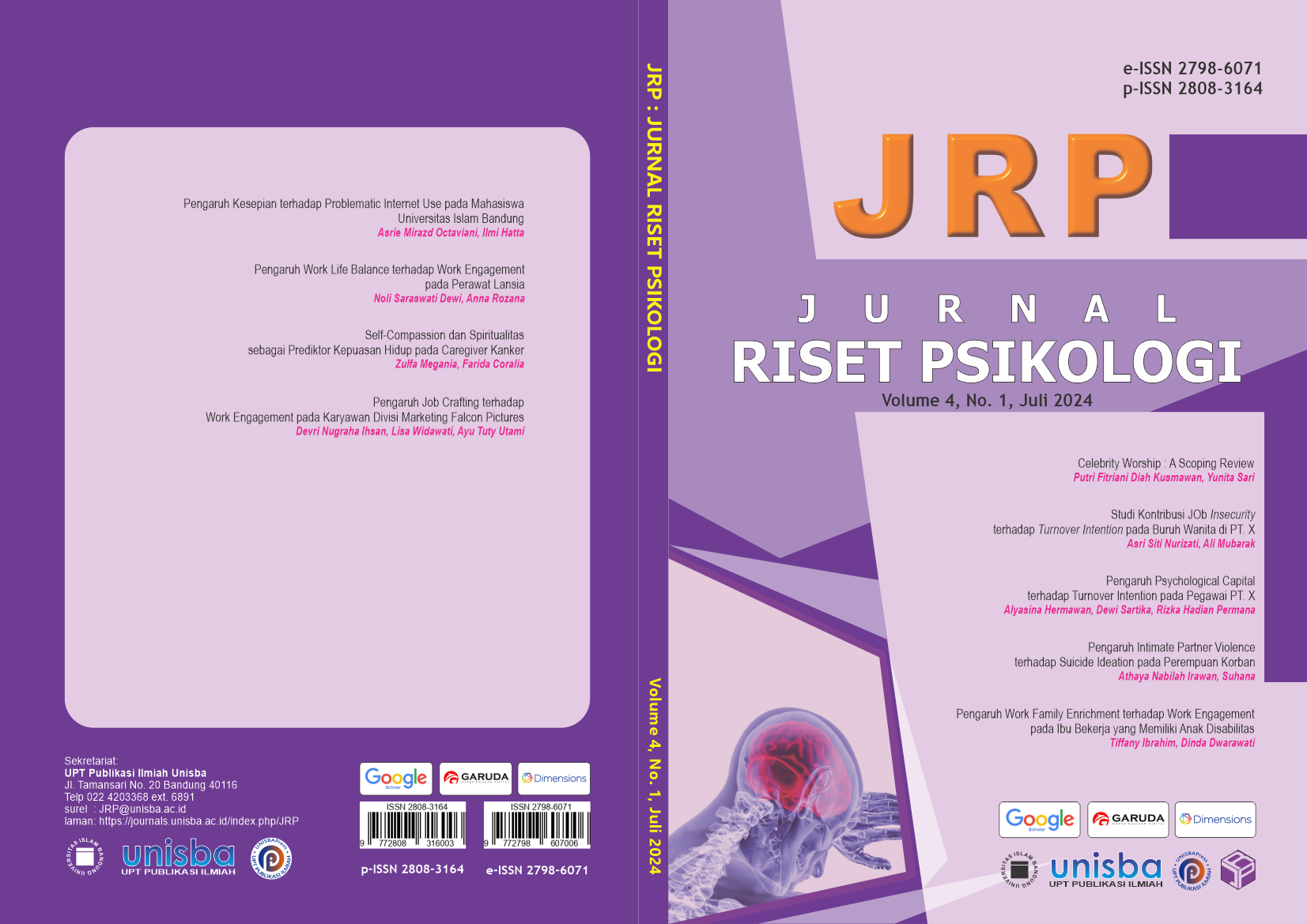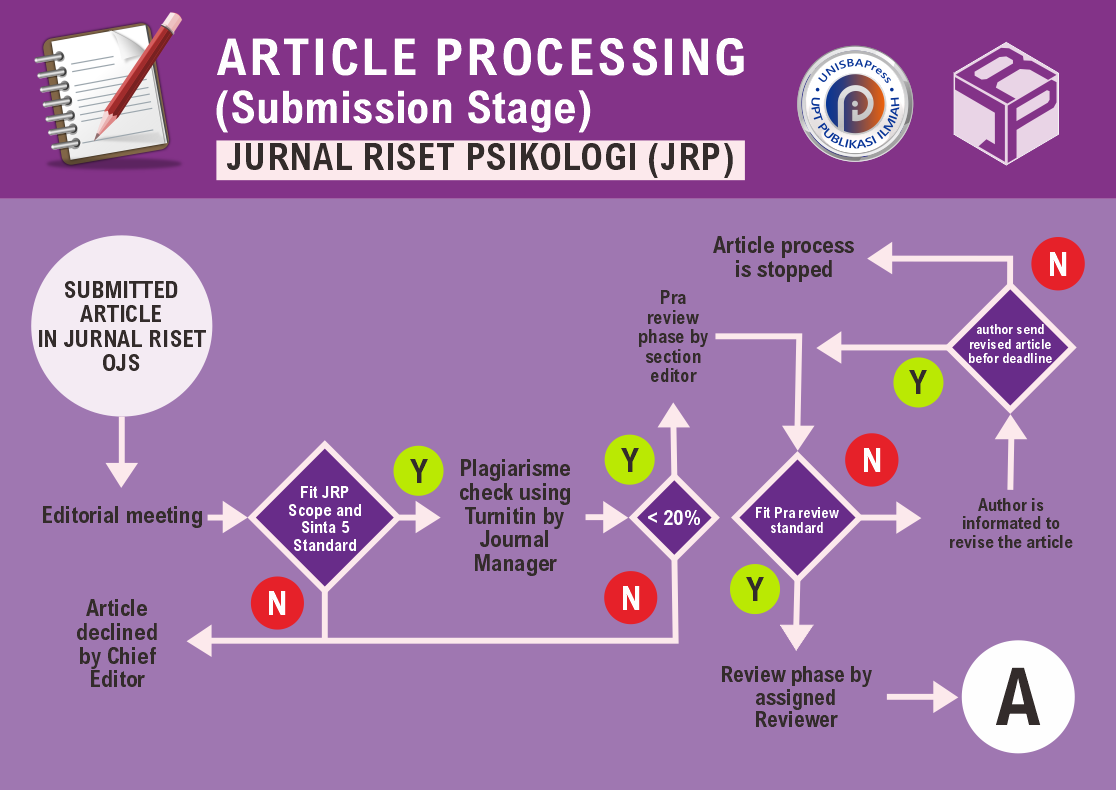Pengaruh Job Crafting terhadap Work Engagement pada Karyawan Divisi Marketing Falcon Pictures
DOI:
https://doi.org/10.29313/jrp.v4i1.4046Keywords:
Job Crafting, Work EngagementAbstract
Abstract. Job crafting is an effort made actively by individuals to balance job demand and job resources. Through job crafting efforts, work engagement can increase, resulting in good work productivity. This research aims to find out how much influence job crafting has on work engagement among Falcon Pictures marketing division employees. The research method used was quantitative with the number of subjects being 35 employees of the Falcon Pictures marketing division. This research uses the Job Crafting Scale (JCS) measuring instrument from Tims et al., (2012) which has been adapted by Astuti A. (2023) and the Utrecht Work Engagement Scale (UWES) measuring instrument from Schaufeli & Bakker which has been adapted by Aryanti et al. al., (2020). The research results found that 97.1% of Falcon Pictures marketing division employees had high job crafting and 97.1% of Falcon Pictures marketing division employees had high work engagement. In this study, job crafting had a significant influence on work engagement of 71.2%. The results of decreasing hindering job demands have the highest significant influence on work engagement of Falcon Pictures marketing division employees.
Abstrak.
Job crafting merupakan upaya yang dilakukan secara aktif oleh individu untuk menyeimbangkan job demand dan job resources. Melalui upaya job crafting, work engagement dapat meningkat sehingga menghasilkan produktivitas kerja yang baik. Penelitian ini bertujuan untuk mengetahui seberapa besar pengaruh job crafting terhadap work engagement pada karyawan divisi marketing Falcon Pictures. Metode penelitian yang digunakan adalah kuantitatif dengan jumlah subjek 35 karyawan divisi marketing Falcon Pictures. Penelitian ini menggunakan alat ukur Job Crafting Scale (JCS) dari Tims et al., (2012) yang telah diadaptasi oleh Astuti A. (2023) dan alat ukur Utrecht Work Engagement Scale (UWES) dari Schaufeli & Bakker yang telah diadaptasi oleh Aryanti et al.,(2020). Hasil penelitian ditemukan 97,1% karyawan divisi marketing Falcon Pictures memiliki job crafting yang tinggi dan 97,1% karyawan divisi marketing Falcon Pictures memiliki work engagement yang tinggi. Pada penelitian ini job crafting memiliki pengaruh signifikan terhadap work engagement sebesar 71,2%. Hasil decreasing hindering job demands memiliki pengaruh signifikan paling tinggi terhadap work engagement karyawan divisi marketing Falcon Pictures.
References
Soemarsono, “SDM (Sumber Daya Manusia). Pilar Penting Atas Keberhasilan dan Kegagalan Organisasi,” Oct. 19, 2018, KPPN Palangkaraya, Palangkaraya.
S. M. Kompaso and M. S. Sridevi, “Employee Engagement: The Key to Improving Performance,” International Journal of Business and Management, vol. 5, no. 12, Nov. 2010, doi: 10.5539/ijbm.v5n12p89.
M. Ferguson, D. Carlson, Hunter, and D. Whitten, “Skill-Balsed Paly and Employee Performalnce: A Metal-Analysis,” Journal of Applied Psychology, vol. 102, no. 12, pp. 1638–1663, 2017.
A. B. Bakker and M. P. Leiter, Work Engagement : A Handbook of Essential Theory and Research. New York: Psychology Press, 2010. doi: 10.4324/9780203853047.
W. B. Schaufeli, M. Salanova, V. González-romá, and A. B. Bakker, “Themeasurement of Engagement and Burnout: A Two Sample Confirmatoryfactor Analytic Approach.,” J Happiness Stud, vol. 3, no. 1, pp. 71–92, 2002, doi: 10.1023/A:1015630930326.
S. G. Cheche, S. M. A. Muathe, and S. M. Maina, “Employee Engagement, Organisational Commitment and Performance of Selected State Corporations in Kenya,” European Scientific Journal, ESJ, vol. 13, no. 31, p. 317, Nov. 2017, doi: 10.19044/esj.2017.v13n31p317.
E. R. Crawford, J. A. LePine, and B. L. Rich, “Linking job demands and resources to employee engagement and burnout: A theoretical extension and meta-analytic test.,” Journal of Applied Psychology, vol. 95, no. 5, pp. 834–848, Sep. 2010, doi: 10.1037/a0019364.
Gallup, “State of the Global Workplace Report,” Gallup. [Online]. Available: https://www.gallup.com/workplace/349484/state-of-theglobal-workplace-2022-report.aspx
A. B. Bakker and E. Demerouti, “Towards a model of work engagement,” Career Development International, vol. 13, no. 3, pp. 209–223, May 2008, doi: 10.1108/13620430810870476.
A. B. Bakker, J. J. Hakanen, E. Demerouti, and D. Xanthopoulou, “Job resources boost work engagement, particularly when job demands are high.,” J Educ Psychol, vol. 99, no. 2, pp. 274–284, May 2007, doi: 10.1037/0022-0663.99.2.274.
P. A. Syafira and I. Hatta, “Pengaruh Self Determination terhadap Work Engagement pada Mahasiswa Its yang Mengikuti Magang,” Jurnal Riset Psikologi, pp. 69–74, Jul. 2023, doi: 10.29313/jrp.v3i1.2106.
S. K. Parker and C. G. Collins, “Taking Stock: Integrating and Differentiating Multiple Proactive Behaviors,” J Manage, vol. 36, no. 3, pp. 633–662, May 2010, doi: 10.1177/0149206308321554.
M. Tims, A. B. Bakker, and D. Derks, “Development and validation of the job crafting scale,” J Vocat Behav, vol. 80, no. 1, pp. 173–186, Feb. 2012, doi: 10.1016/j.jvb.2011.05.009.
M. Tims, A. B. Bakker, and D. Derks, “Job crafting and job performance: A longitudinal study,” European Journal of Work and Organizational Psychology, vol. 24, no. 6, pp. 914–928, Nov. 2015, doi: 10.1080/1359432X.2014.969245.
G. R. Slemp and D. A. Vella-Brodrick, “Optimising Employee Mental Health: The Relationship Between Intrinsic Need Satisfaction, Job Crafting, and Employee Well-Being,” J Happiness Stud, vol. 15, no. 4, pp. 957–977, Aug. 2014, doi: 10.1007/s10902-013-9458-3.
A. B. Bakker and W. G. M. Oerlemans, “Daily job crafting and momentary work engagement: A self-determination and self-regulation perspective,” J Vocat Behav, vol. 112, pp. 417–430, Jun. 2019, doi: 10.1016/j.jvb.2018.12.005.
C. D. Kirkendall, “Job Crafting: the Pursuit of Happiness At Work.,” 2013, Browse all Theses and Dissertations, Dayton.
S. Adler, “Work Engagement: A Handbook of Essential Theory and Research edited by Arnold B. Bakker and Michael P. Leiter,” Pers Psychol, vol. 65, no. 1, pp. 204–207, Mar. 2012, doi: 10.1111/j.1744-6570.2011.01242_2.x.
H. M. NGUYEN, C. NGUYEN, T. T. NGO, and L. V. NGUYEN, “The Effects of Job Crafting on Work Engagement and Work Performance: A Study of Vietnamese Commercial Banks,” The Journal of Asian Finance, Economics and Business, vol. 6, no. 2, pp. 189–201, Apr. 2019, doi: 10.13106/jafeb.2019.vol6.no2.189.
M. Radstaak and A. Hennes, “Leader–member exchange fosters work engagement: The mediating role of job crafting,” SA Journal of Industrial Psychology, vol. 43, no. 0, Jan. 2017, doi: 10.4102/sajip.v43i0.1458.
R. Mislim, “Job crafting in organizations: A valuable approach for job performance or just a theoretical framework?,” Radboud University Nijmegen, Nijmegen, 2015.
R. D. Aryanti, E. Y. D. Sari, and H. S. Widiana, “APLIKASI MODEL RASCH PADA SKALA WORK ENGAGEMENT (UTRECHT WORK ENGAGEMENT SCALE),” Jurnal Psikologi Integratif, vol. 8, no. 2, p. 61, Jan. 2021, doi: 10.14421/jpsi.v8i2.2108.
S. P. Robbins and T. A. Judge, ORGANIZATIONAL BEHAVIOR, 15th edition. New Jersey: Pearson Prentice Hall, 2013.













